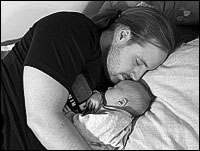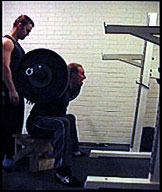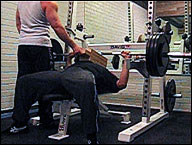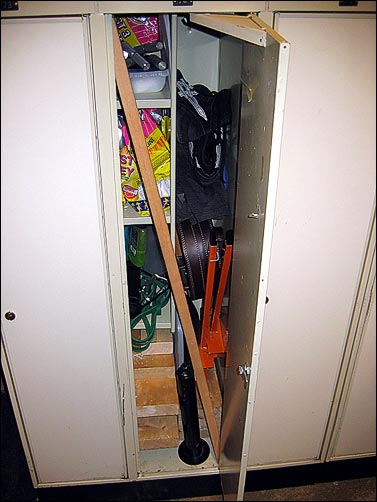Archives for general (page 6)
June 28, 2005
March 29, 2005
Hope you all had a relaxing Easter Holiday!

No gangsta rabbits this year… but someone clearly had a dozen eggs too many.
March 17, 2005
Powerlifting as a drug-free raw Olympic sport??!
Kieran Kidder, the man behind the WPC, WPO and APF powerlifting federations made an interesting announcement on GoHeavy yesterday. The offshoot of it is that six leaders of major American powerlifting organizations agreed to jointly host a unified national meet, simply called the United States Powerlifting Nationals, in Las Vegas in late fall 2005. Why? Well, to reach approval with the United States Olympic Committee. Here’s the chewy bits:
We have factual knowledge that the USOC/IOC have strongly considered powerlifting becoming an Olympic Sport. But there is one definitive factor that is preventing this from happening. That being the fragmented state of powerlifting in the USA with the over abundance of powerlifting federations. The powers that be who regulate potential new Olympic Sports have no idea who/what drug free powerlifting organization would represent America. That’s the bottom line!!
The only solution is to have a Unified National meet to put us in good graces with the USOC/IOC. The meet will be simply called the United States Powerlifting Nationals. For this to happen there will be changes that some lifters might not be used to depending on which of the 6 federations lifters have lifted in. There has to be one set of rules used to run the meet. We have been asked to use the IPF rules by the powers that be. This is in no way shape or form an IPF meet!! The IPF rules are just being used as guide to go by so this unprecedented event can take place. For the first 1-2 years single ply squat suits, bench shirts, grove briefs will be allowed(poly/denim only, no canvas). The gear is being allowed to get the ball rolling since gear is the norm in powerlifting presently. Keep in mind that if the IOC allows powerlifting to become an Olympic Sport there will be no supportive gear allowed. Just like the olympic lifters who are only permitted to wear, wrist wraps, minimal knee wrap, and a belt. Also there will be no mono-lift either. As far as the drug testing goes a totally neutral testing lab called WADA (Wolrd Anti Doping Agency) who oversees all olympic drug testing will handle the testing. The Presidents of the 6 federations will put together teams to represent their federation in this unified effort. Any lifter who hasn’t lifted in the 6 federations involved, can join one of the 6 federations if he/she wishes to be part of this awesome powerlifting movemnet. Just putting up total in the between now and the meet is all thats required. If your already a member of one of the 6 federations having done an official total in the past year is all thats required.
[my emphasis, spelling mistakes his]
This is great news, but the hurdles facing this project would appear to be both numerous and tall. It is no secret that the powerlifting elite relies heavily on drugs - the politically correct terms are enhanced or assisted lifting - to achieve nicely bending barbells, while generally being vocally for equipment often citing injury prevention as a key theme. Whatever the amount of support an Olympic branch of powerlifting would get or not get, the success of this project would help bring raw lifting to the fore (we all know how drug-free the Olympics are despite cautionary optimism from WADA). In the final analysis, equipped lifting is just a bit too kinky anyway. Don’t believe me? Take a look at this and that.
While on the topic of… enhanced… lifting, here’s something I don’t quite get. In the States, many renown lifters have been quite open about their steroid use, among them Louie Simmons (who back in 1998 stated that he has done anabolic steroids straight for 28 years without cycling), Mike Miller and the great Ed Coan. I respect their openness, but isn’t steroid use illegal in the States making these admissions of criminal guilt? Or are we to believe that they all have legal prescriptions? Perhaps you can’t prosecute based on them, but intuitively this appears about as wise as admitting theft or cocaine dealing online. I’ve never heard of any European lifter being this bold, but I stand to be corrected if you please.
February 26, 2005
Towards lofty theoretical heights
During the twenty-one months I have been powerlifting, my acquisitions have revolved around videos and equipment. A lot of the finer points of technique are still eluding me no doubt, but at this point my repository of technical information appears adequate for my needs - despite not yet being the happy owner of the Elite FTS Exercise Index Squat-Deadlift DVD. Equipment wise, I’m also quite well adjusted to the demands of basic powerlifting training, grip work and rehab (my closet is begging for mercy) . I might need some more bands, and possibly a bench shirt, for accessory work, but the rest (buffalo bar, more Ironmind grip tools…) is icing on the cake rather than immediate requisites. Time to change focus.
Enter reading project. After having gotten most of my theoretical reads from the net in a predigested form, I will now turn to the source and read the main body of the literature that Louie Simmons has used in creating the Westside system. Much of this material comes from the former communist bloc and is based on very rigorous Soviet research on strength training; Sportivny Press claims that the data in their translated Russian manuals “has been gathered from a huge pool of athletes - - over 300,000 weightlifters”. I hope to emerge from my library with a much deepened understanding of strength training and, thus, a much better understanding of my own training. Besides, a book is a great thing to have when you have a sleeping son cuddled up in your lap.
The reading list is based on the Westside FAQ and grouped according to where it is the cheapest to order from to Finland. I will buy used copies when available; get in touch if you have any of the below titles and want to get rid of them. Note that I’m going to strike out titles I’ve purchased and post a comment with the details of every purchase until this project is complete. A rough estimate puts the value of these works at around 400€ without shipping, a cost that appears quite reasonable when distributed over the long haul (I’m hoping to finish this project by end of 2005 the latest). Unfortunately, these items are too specialized to be found in the local public libraries… Here goes:
SSPower (voimaharjoittelu.net)
Supertraining by Siff and VerkhoshanskyAmazon.com
Science and Practice of Strength Training by Zatsiorsky
Science of Sports Training by Kurz
Periodization: Theory and Methodology of Training by Bompa
Power by Hatfield(lots of used copies available dirt cheap)Sportivny Press
Weightlifting Training & Technique by Zhekov
A System of Multi-Year Training in Weightlifting by Medvedyev
A Program of Multi-Year Training in Weightlifting by Medvedyev
The Training of the Weightlifter by Roman
Managing the Training of Weightlifters by Laputin
Fundamentals of Special Strength Training in Sport by Verkhoshansky
Weightlifting Year books 1980-1985
Programming and Organization of Training by VerkhoshanskyOut of print and hard to find
Secrets of Soviet Sports and Fitness Training by Yessis
Periodization of Strength by Bompa
Note that Elite Fitness Systems is not on that list due to their ridiculously high international shipping fees caused by now only providing UPS shipping for their products. As an example, I wanted to order the new Dynamic Bench Manual, but paying $58.64 in shipping for a thin booklet that retails for $16.95 effectively put an end to that (screenshot). When I inquired about this seemingly effective way to thwart international business, I was told that the company dropped the regular airmail option since they were losing too many packages making reshipping them too expensive. I was further told that their ordering system ties directly into UPS, but that they regrettably don’t get any international shipping discounts due to their mail volume being too small (compare regular UPS rates to Amazon’s UPS rates and you’ll see a whopping difference). Of course, I cannot argue with their decision, but I simply cannot afford to be a regular customer of this great company any longer unless I ask someone in the US to order for me and send the merchandise onward ($7.20 for shipping to California sounds much more reasonable, add $5 or so for airmail to Finland). It should also be noted that within the European Union, shipping costs are added to the value of the goods to be imported when determining the import tax thus further escalating this financial violence of sorts when a 22% VAT plus a 3.5% toll fee is slapped on top.
I suspect I am not the only European powerlifter who now turn his eyes towards the EliteFTS reseller in Europe, SSPower here in Finland. The prices are a tad higher, the selection smaller and it generally takes a few weeks for novelties to arrive, but the friendly shipping costs more than makes up for that. Now, SSPower recently started enforcing a 30€ minimum on all orders, but that’s another [minor] rant. In fact, I’m just about to point my browser that way to get my first and most important reading, Supertraining, that just happens to be on a 16€ discount making it a lot cheaper for me than any other sources I know of.
Prepare for a much more theoretical Under the Bar experience!
February 24, 2005
An unforgettable 4kg moment
 Last Saturday it finally happened. I had prepared for a long labor by stocking up with protein shakes and energy drinks, not to mention some pre-sliced salami. We arrived at the hospital at 1pm, three hours later our son was born powered by no pain medication on Sanna’s part and only a single shake on my part. After being there for Sanna, I have newfound respect for the mothers of this world. Raising the GPP of my delts and changing diapers will be the only exercise I will be up to for the next few days… Happiness is a warm baby. Who cares about PRs?
Last Saturday it finally happened. I had prepared for a long labor by stocking up with protein shakes and energy drinks, not to mention some pre-sliced salami. We arrived at the hospital at 1pm, three hours later our son was born powered by no pain medication on Sanna’s part and only a single shake on my part. After being there for Sanna, I have newfound respect for the mothers of this world. Raising the GPP of my delts and changing diapers will be the only exercise I will be up to for the next few days… Happiness is a warm baby. Who cares about PRs?
Pictures and the rest at the “Norbert” page…
January 31, 2005
Nice logic
Speaking of glute-ham raises, found this important alert over at Kitty’s Consumer Beware! Board.
See the following document that says that the GHR doesn’t kill hair permanently.
http://www.fda.gov/ohrms/dockets/98fr/102698a.txt
So, the GHR is a waste of money.
You have been duly warned.
January 23, 2005
How to use the Westside Powerlifting Method for Bodybuilding
Westside Barbell is not great news on Dave DePew’s Fitness & Nutrition Hour with a long interview having been done with Louie Simmons (4 Oct 2004) and a segment on using Westside methods for American football with New Jersey Personal Trainer Joe DeFranco (13 Dec 2004). On Thursday, Louie was on again, but this time not on powerlifting but on How to use the Westside Powerlifting Method for Bodybuilding.
The impression I get from this interview is not that Louie is on a crusade to spread the gospel to bodybuilders, but rather has been invited to have his brained ticked on how he would adapt Westside for bodybuilding. Here’s a quick rundown of the interview that gets rolling after a whopping 2:30 minutes of advertisement.
Training cycle
Variety is very important for bodybuilders and the conjugated method should thus be used. Whereas Westside powerlifters would use a different bar every time they squat, bodybuilders do very well with things like doing leg presses at different gyms to hit the muscles from slightly different angles. Training should revolve around a weekly or monthly cycle at most, with nothing done for more than three weeks lest you want your body to stop progressing. “Get the large exercises out of the way first, then move into specifically what you need”.
Reps and sets
A novice bodybuilder would benefit from heavy training, as “powerlifting is basic bodybuilding” and novice bodybuilders will need to have something to cut in the first place - the stronger you are the better a bodybuilder you will be. More advanced bodybuilders would do well training around 70-80% of max.
6 reps for about 5 sets at 70% to build muscle hypertrophy
4 reps for about 5-6 sets at 80%
Stay away from the 90%, no need for it for bodybuilding
Bar speed and bands
Powerlifters generally move the bar quickly, but bodybuilders should move it slowly to eliminate momentum and work the muscle efficiently throughout the motion. Bands should be used, but fought every inch of the way with Louie recommending a 3 second or so eccentric. Tension should be kept on the muscle throughout the set; Louie mentions not allowing IFBB bodybuilder Mike Francois to lock out when he trained at Westside (Francois wrote a short column about training at Westside).
Louie reports having seen great success with using bands together with machines for bodybuilders. In the earlier interview mentioned above, Louie makes the observation that many bodybuilding machines, such as the pec deck, are heaviest at the bottom; here bands can help even out the resistance curve by making the top heavier thus working the muscle harder. In short, bodybuilders should, like powerlifters, continuously think about how to change things even for the same exercise.
Use of partials
Floor press should be used, but Louie recommends against doing too many partials as they can be a bit dangerous, especially board presses (”the only pec injuries we ever incur is doing board press”). The focus should be on full range movements such as benching with different grips.
Waist size
The interview ends with a question on whether the quest for a thin waistline will hinder strength development for bodybuilders. “So you’re not going to get a bodybuilder squat 900 pounds, that’s all there is to it.” There are bodybuilders, such as Ronnie Coleman, who are freaky strong despite having a thin waistline, but they are rather the exception than the rule. Louie recommends a lot of belt squatting and exercises without a bar on the back to keep waist size down. In conclusion, he notes that a lot of bodybuilders have larger waists than they say they do, but the size of their shoulders and legs tends to obscure this fact.
Now, where is the blog dedicated to Westside bodybuilding?
January 20, 2005
January 18, 2005
The Reinvention Tour
Alberto Caraballo, a familiar face over at GoHeavy.com and a reader of this humble blog, opened his own shop aptly titled The Reinvention Tour. In my twisted mind, I take the name as a gentle reminder that lifting is really about rediscovering what so many lifters before you have learned for themselves. Be that as it may, yet another supreme reason to get serious about RSS.
January 17, 2005
Week 2: Ride the lightning
Monday, 10 Jan 2005: Squat/Deadlift
 The days of sleeping 12 hours a night are over. Sleep deprivation draws near.
The days of sleeping 12 hours a night are over. Sleep deprivation draws near.
If I had to pick one word to describe today’s workout, it would be “reassuring”. After doing the usual speed work, this time with 60 kg/133 lbs, I pyramided up to a 110 kg/234 lbs slightly below parallel box squat (13″). This rep looked fairly good; in fact, sat back a lot more than on the speed work. Embarrassing as it is, this is only 5 kg/11 lbs less than my recorded pre-injury PR off the very same box. Wisely decided to leave PR breaking for the next heavy box session two weeks from now, because a) I was squatting outside the rack to accommodate the widened stance and b) play it safe from a back standpoint (although I do feel it can now take most anything I can dish out in good form on the box). Since I’m just returning to heavy squat/deadlift training, I hope I could reap some beginner’s gains this year and see a hefty increase in weights. I need it before I outbench my squat. Now THAT would be embarrassing. Three plates off this box is my next goal.
Box squat, 13″ (belt):
5x2 @ 60 kg/111 lbs
worked up to 1 @ 110 kg/243 lbs
4 @ 95 kg/210 lbs
Good mornings off pins (mid-stomach):
worked up to 10 @ 80 kg/177 lbs
Hanging leg raise: 10,7,7,6
2 supersets:
Rolling Thunder reverse cable curl: 6,6 @ 20 kg/44 lbs
Captains of Crush: 8 @ I + negatives with II
Total training time: about an hour
Wednesday, 12 Jan 2005: Bench
 Oh la la! Had been feeling ready to bench for much of last week, but waking up today I had some VERY tender pecs (felt like the pectoralis minor). What is strange is that I have no idea what caused it, the only thing I can come up with are the hanging leg raises I did on Monday… and even that takes a leap of imagination involving hunched shoulders and possibly green men from Mars. I wanted to go for a new bench max today, but instead felt obliged to get the sore pecs out of the equation with three board presses. I don’t regret it for a second, because I put up a new shiny PR by doing an easy 120 kg/265 lbs before failing with 130 kg/287 lbs. After a year of nothing, I am in heaven. In a matter of a couple of weeks, 100 kg/221 lbs has gone from being something big to a good weight to stop over by to gauge the form of the day. Continued with some floor presses, but was fairly beat after having pyramided down following the 130 kg/287 lbs attempt.
Oh la la! Had been feeling ready to bench for much of last week, but waking up today I had some VERY tender pecs (felt like the pectoralis minor). What is strange is that I have no idea what caused it, the only thing I can come up with are the hanging leg raises I did on Monday… and even that takes a leap of imagination involving hunched shoulders and possibly green men from Mars. I wanted to go for a new bench max today, but instead felt obliged to get the sore pecs out of the equation with three board presses. I don’t regret it for a second, because I put up a new shiny PR by doing an easy 120 kg/265 lbs before failing with 130 kg/287 lbs. After a year of nothing, I am in heaven. In a matter of a couple of weeks, 100 kg/221 lbs has gone from being something big to a good weight to stop over by to gauge the form of the day. Continued with some floor presses, but was fairly beat after having pyramided down following the 130 kg/287 lbs attempt.
Next week, I will put in some much anticipated dumbell work over at another gym to give the system a rest from all the heavy singles. Then time for a new bench max I suspect.
Three-board press:
worked up to 2 @ 100 kg/221 lbs
2 @ 110 kg/243 lbs
1 @ 120 kg/265 lbs
0 @ 130 kg/287 lbs
0 @ 125 kg/276 lbs
0 @ 122.5 kg/271 lbs
Close-grip floor press:
worked up to 3 @ 90 kg/199 lbs
Lying dumbell extension: 7,5 @ 18.5 kg/41 lbs
One handed-lat pulldown (kneeling):
2x6 @ 40 kg/88 lbs
2x12 @ 30 kg/66 lbs
Total training time: about 70 minutes I guess
Friday, 14 Jan 2005: Accessory
Today’s workout was plain fun (aren’t they always?) as I discovered stiff-legged deadlifts on the balance board (found them in my head). If you’re looking for a very functional low back/hamstring movement that feels like deadlifting in a rowing boat in the middle of a storm, this is IT. Don’t expect the weight to always come up in a straight line, it won’t. Definitively not for core beginners. Will take a clip of these at some point. For now, you will just have to live with this week’s clip (5.6MB).
Also did some fun stuff for the biceps. Haven’t done down the racks since I was a bodybuilder, but now I am shamelessly employing bodybuilding methods to pack some size unto the front of my arms to match the triceps that march to the tune of relentless pressing. In case you didn’t now, down the rack involves working your way down the dumbell rack by picking up a lighter pair of bells every time you hit failure. I usually keep dropping till I reach a weight that I can suddenly crank out 10-20 reps with. At that point the muscle has usually gone numb and could use an oxygen break.
Pulldown to head: 3x15 @ 70 kg/155 lbs
Incline dumbell curl, down the rack (all sets below done in succession without rest):
5 @ 21 kg/46 lbs + 1 @ 18.5 kg/41 lbs + 3 @ 16 kg/35 lbs + 3 @ 13.5 kg/30 lbs + 6 @ 10 kg/22 lbs + 10 @ 8 kg/18 lbs (total: 28 reps)
4 circuits of:
Standing cable crunch with 3 isometric holds of 5 seconds: 5 @ 30 kg/66 lbs / 7,3,3 @ 40 kg/88 lbs
Upper body cable turn: 25,25,25,25 @ 50 kg/111 lbs
Stiff-legged dead on balance board: 10,10,10,10 @ 50 kg/111 lbs
Rolling Thunder holds: 2x30 kg/66 lbs
Total training time: 52 minutes
Circuit 1: ? min, circuit 2: 5:05 min, circuit 3: 3:30 min, circuit 4: 4:20 min

